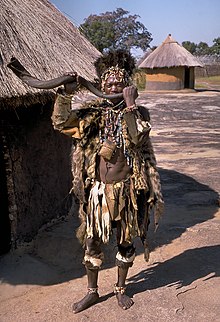Indigenous religion in Zimbabwe
| Part of a series on the |
| Culture of Zimbabwe |
|---|
 |
| History |
| People |
| Languages |
| Cuisine |
| Religion |
| Art |
| Sport |
Indigenous religion in Zimbabwe is explained in terms of the Zimbabwe ethnic groups, beliefs, norms and values, rites and rituals, ceremonies and celebrations. Indigenous religion is more carried out by living it than with its theory. Religion among the Africans is very important, it plays a vital role for the individuals, the family and the community as a whole. Bourdlillon asserts that indigenous religion is one, though there can be various manifestation just like Christianity which is one but has various denominations.[1] Thomas Gale defined the word indigenous as to anything that is native to a particular geographical culture. Mbiti says in Zimbabwe Indigenous religion is in two classes, the Ndebele and Shona.[1][2][3][4] However, Zimbabwe has a lot of minority tribes including the Tonga, Venda, Kalanga and Sothu.
Characteristics of Indigenous Religion[]
The existence of spirits[]

In indigenous religion, the activities and actions of Spirits govern all social and spiritual phenomena.
The Shona and Ndebele people believe that spirits are everywhere, spirits coexist with people.[5]
Belief in God[]
Zimbabweans believe in God the Supreme Being who is referred to by many names depending on the tribe and occasion. Ndebele call him, uNkulunkulu, uThixo, uMdali or uMvelinqangi. The Shona call him Mwari and Ishe.
Belief in life after death[]
It is believed that when one dies, he/she lives on and can still hear and make decisions on life thus taking an ancestral form living in the world of the spirits. There is communication between the dead and the living, whom the living believe to be their guardians in life.
Ancestral Spirits[]
An ancestor is any person from whom one is a descendant.
In indigenous religion, ancestors are appeased during hard times so the ancestors help them. Their Duties
- They are regarded as good and important
- They are protectors of people, land (territorial spirits)
- intermediates between people and Supreme being
- They do not cause harm
- Fight evil spirits away from their family
- Influence proper moral behavior
Sacred places[]



There are a lot of these places in Zimbabwe. It is a place where the spirits dwell. These are holy, godly or divine and highly respected places. They are significant because that is where the sacred practitioner communicates with the ancestors. These can be a hill, caves, rivers, trees and mountains. Examples include Njelele, Gulabahwe Cave, Silozwana caves, Diana’s pool and Chinhoyi Caves.[6]
Ceremonies[]
It is orally transmitted[]
There is no scripture or sacred text. These are transmitted orally; by word of mouth from one generation to the other.
Moral Code[]
The indigenous religion has a strong moral code based on the sacredness of other being.[7] Failure to adhere to the moral code has strong repercussions in the afterlife. Respect for elders and honoring parents is one of the adhered to moral code. Killing, witchcraft, stealing, injuring others are some of the forbidden things through the moral code.
The concept of Ubuntu means that a human being cannot exist as a human being in isolation.(Louw, 1998)
Historical spirit mediums[]
- Mbuya Nehanda
- Sekuru Kaguvi
- Sekemutema
References[]
- ^ a b Bourdillon, M. F. C. (1982). The Shona peoples : an ethnography of the contemporary Shona, with special reference to their religion (Rev. ed., 2nd rev. ed.). Gweru [Zimbabwe]: Mambo Press. ISBN 0-86922-188-4. OCLC 9679472.
- ^ Bozongwana, W. (1983). Ndebele religion and customs. Literature Bureau. Gweru: Mambo Press in association with the Literature Bureau. ISBN 0-86922-254-6. OCLC 11960351.
- ^ a b c Ndhlukula, N. P. (1980). Imvelo lolimi lwesiNdebele. Zimbabwe Literature Bureau. Gweru: Mambo Press. ISBN 0-86922-146-9. OCLC 896466170.
- ^ Mbiti, John S. (1991). Introduction to African religion (2nd rev. ed.). Oxford [England]: Heinemann Educational Books. ISBN 0-435-94002-3. OCLC 24376978.
- ^ Preservation of Ndebele art and architecture. Violette Kee Tui, Pathisa Nyathi. Bulawayo. 2018. ISBN 978-0-7974-9314-8. OCLC 1119748168.
{{cite book}}: CS1 maint: others (link) - ^ Burrett, Robert S. (2016). The Matobo Hills : Zimbabwe's sacred landscape. Moira FitzPatrick, Julia Duprée (First ed.). Bulawayo, Zimbabwe. ISBN 978-0-7974-9808-2. OCLC 986991272.
- ^ Ndlovu, Tommy Matshakayile (1995). Imikhuba lamasiko AmaNdebele. Doris Ndlovu, Bekithemba S. Ncube. Gweru, Zimbabwe: Mambo Press. ISBN 0-86922-624-X. OCLC 34114180.
- Traditional African religions
- Religion in Zimbabwe